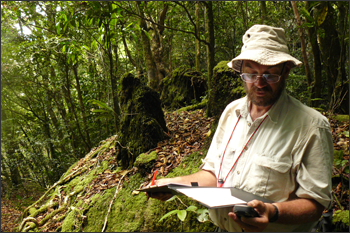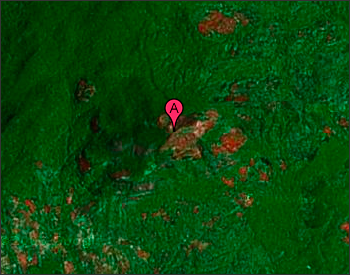
In 2005, conservation scientist Dr. Julian Bayliss was looking at Landsat images of northern Mozambique with Google Earth. He was in search of regions close to Malawi’sMt. Mulanje that could form potential transfrontier conservation areas. Using the Landsat imagery, Bayliss made note of proximate mountainous green patches, knowing that greater rainfall levels at higher elevations meant those patches could be forest. He then conducted reconnaissance trips to each of these candidate locations.
As related by Bayliss, after climbing up Mozambique’s Mount Mabu, he and his colleagues, “observed a large area of wet forest in the distance; the next day we trekked into this area to discover a pristine forest in excellent condition.”
“Obviously I wanted to calculate the size of this area as it seemed to stretch from horizon to horizon,” Bayliss said. “For this, I revisited the Landsat imagery.”
After using Landsat data to determine the forest extent, Bayliss and his colleagues at the Royal Botanical Gardens Kew decided an expedition was in order. In October and November of 2008, 28 scientists visited Mount Mabu and discovered a cornucopia of wildlife there including three new species of butterflies and a new snake species.
Details as reported in the RBG Kew Press Release:
Scientists based at the Royal Botanic Gardens, Kew (RBG Kew) have led the first expedition to the previously unmapped Mount Mabu in northern Mozambique, funded by the Darwin Initiative. The expedition is part of RBG Kew’s ongoing work with Mozambique’s government to identify priority areas for conservation in the face of rapid development.
Until just three years ago the vast area of forest was known only to villagers nearby. The team ‘found’ Mount Mabu after looking at Google Earth maps in 2005 while trying to finding a site for a conservation project, looking at land above 1,600m where higher rainfall means there is likely to be forest.
Locally-based conservationist Julian Bayliss investigated the unexpected patch of green and used satellite photos to identify a large, unexplored forest. Following a series of scoping trips, in October and November this year an international team of 28 scientists and support staff from the UK, Mozambique, Malawi, Tanzania, Belgium and Switzerland hiked into it.
Expedition leader, RBG Kew botanist Jonathan Timberlake said “The phenomenal diversity is just mind-boggling: seeing how things are adapted to little niches, to me this is the incredible thing. Even today we cannot say we know all of the world’s key areas for biodiversity – there are still new ones to discover.”
They found a wealth of wildlife including pygmy chameleons, Swynnerton’s robin, butterflies such as the Small Striped Swordtail and Emperor Swallowtail as well as three new species, a previously undiscovered species of adder and many exotic plants, including a rarely seen orchid. The team brought back over 500 plant specimens and are looking forward to finding out more about the species they collected.

Jonathan continues: “This is potentially the biggest area of medium-altitude forest I’m aware of in southern Africa, yet it was not on the map, and most Mozambicans would not have even recognized the name Mount Mabu. Kew is working with the Mozambique government to protect areas like Mount Mabu and encourage local people to value the forest for its wildlife. By conserving the plant life we can help secure a future for all the other creatures we saw there.”
RBG Kew is using its expertise and collections, coupled with Mozambique collections, to identify new species and areas of new interest for biodiversity. RBG Kew also works to build capacity with local partners to enable them to carry out similar work in the future.
The expedition was led by RBG Kew working with colleagues from the Mozambique Agronomic Research Institute (IIAM), Birdlife International and the Mulanji Mountain conservation Trust (MMCT) in Malawi.
Outside the forest the country’s roads and buildings have been badly affected by a civil war that lasted from 1975 to 1992, but inside scientists found the landscape was almost untouched. Ignorance of its existence, poor access and the forest’s value as a refuge for villagers during the fighting had combined to protect it.
With local people returning to the area, and Mozambique’s economy booming, there is a risk that this precious oasis of life will come under pressure as the forest is cut for wood or burnt to make space for crops.
+ Read the Royal Botanical Garden, Kew press release [external link]

Be Part of What’s Next: Emerging Applications of Landsat at AGU24
Anyone making innovative use of Landsat data to meet societal needs today and during coming decades is encouraged to submit and abstract for the upcoming “Emerging Science Applications of Landsat” session at AGU24.





